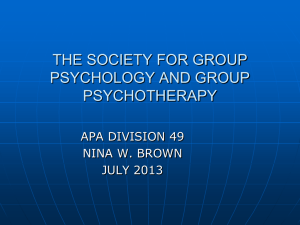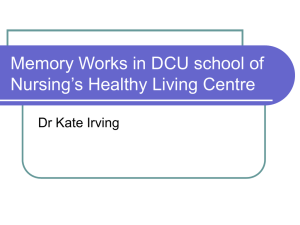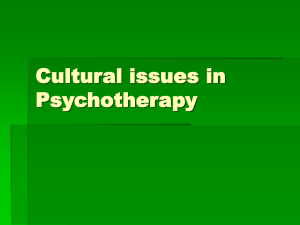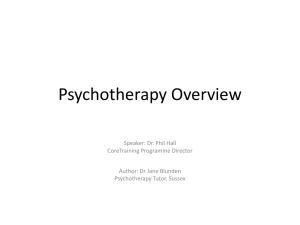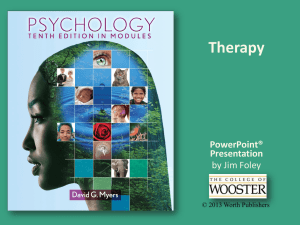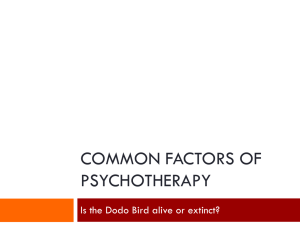101年3月份心理治療訓練課程
advertisement
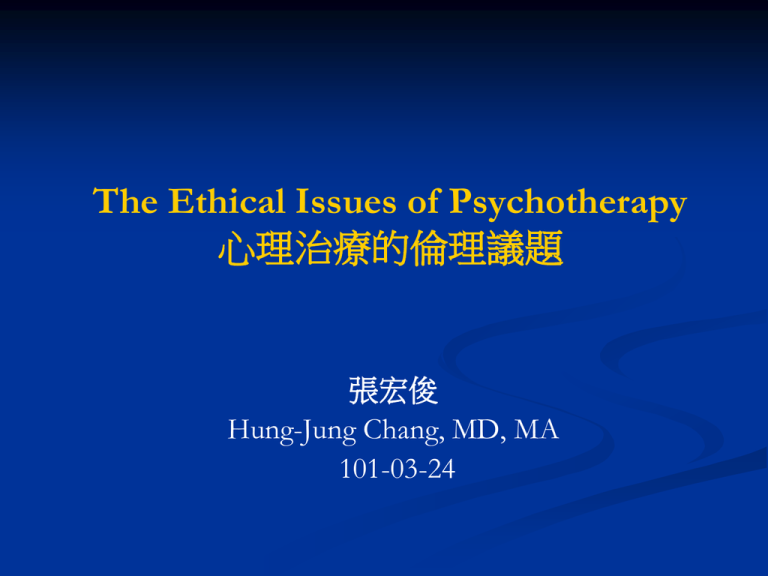
The Ethical Issues of Psychotherapy 心理治療的倫理議題 張宏俊 Hung-Jung Chang, MD, MA 101-03-24 大綱 Outline Introduction The Beneficence Issues in Psychotherapy The Autonomy Issues in Psychotherapy The Non-maleficence Issues in Psychotherapy The Justice Issues in Psychotherapy Conclusion- How ethics affect psychotherapy? 倫理的理論與運用 The Theory and Practice of Ethics Theory: The illustration of “ought and should” in interpersonal relationship Practice: Working with dilemmas in human relationship/making space for and reflecting on different values between people In health care: Ethical problems are commonly viewed as the tension between two or more morally defensible alternative actions, including inaction. 3 The Affinity between Ethics and Psychotherapy Ethics Psychotherapy Theory: the illustration of “ought and should” in interpersonal relationship Practice: Working with dilemmas in human relationship/making space for and reflecting on different values between people Theory: relating to what happens between people within the interpersonal space, both conscious and unconscious Practice: people thinking together about human dilemmas, within a boundaried space Adopted from: Michael S. Gazzaniga, Richhard B. Ivry, George R. Mangun: Cognitive Neuroscience-The Biology of The Mind, 2009,W.W. Norton, New York:631 5 如何處理倫理困境?(1) How should we make difficult ethical decision?(1) We need to find some mechanism for resolving ethical dilemmas that goes beyond an appeal to our ‘gut instincts’. In order to convince others, it is necessary to point to some coherent reasoning process, or moral principle, which explains or justifies one’s position. It is usually not possible for bioethics to look for an right answer. One possibility might be that reasoned argument and deliberation is simply the most rational way to resolve difficult or controversial questions. 6 如何處理倫理困境?(2) How should we make difficult ethical decision?(2) 基本倫理理論 Basic Moral Theories: 效益論/結果論 Utilitariansim /Consequalialism judges an action/inaction by its consequences or outcomes. 道義論 Deontology (Duty) based on the argument that moral duties or obligations determine whether an action/inaction is moral or immoral. Deontologists concern the rightness of an action itself and the respect for a person’s rights. 德行論 Virtue ethics is concerned with working out what a “virtuous” person would do in a particular situation. Virtue ethics values intention. 7 如何處理倫理困境?(3) How should we make difficult ethical decision?(3) 當代的生命倫理學 Contemporary bioethics 原則論 Principlism The ‘principlist’ approach lay out for key principles: autonomy, beneficence, non-maleficence, and justice. 決疑論 Casuistry (Case) In casuistry, in stead of starting with broad, abstract theories and principles (a top-down approach), we instead begin with our response to concrete cases and reason by analogy (a bottom-up approach). 8 「我是師姊…」-精神科居家治療個案-1 A君,男性,26歲,未婚,國立大學會計系畢業 畢業退伍後,民國99年底進入某會計事務所任職,不久後 被派至大陸深圳,A表示他在大陸工作壓力很大(被迫作假 帳、曾被公司其他幹部持槍威脅…) , 100年初君即因失眠、 情緒不穩、自殺意念等問題被遣送回台並且離職。 回台後,家人即發現A會自言自語、比手劃脚,並出現半夜 跑去墳場的怪異行為。家人幾次帶至精神科門診治療,但A 自認沒病,拒絕服藥。雖家人會將藥物加入食物騙他服用, 終究A的病情日益嚴重… 9 「我是師姊…」-精神科居家治療個案-2 100年7月,A終於在一次與家人衝突時,以穢語辱駡家人 並在4樓陽台聲稱要跳樓自殺, 被送至某精神科專科醫院 急診後住院治療。 住院3週後,症狀有明顯改善,在A要求下,醫師同意其出 院轉門診治療。 門診追踪期間,A沒有明顯的症狀, 在家準備會計師執照 考試。然而A始終不認為自己生病,他表示在考前會配合 吃藥,但考後即決定不再返診並拒絕吃藥。在家人與醫師 討論後決定轉介居家治療。 10 「我是師姊…」-精神科居家治療個案-3 居家治療護理師在收到轉介單後,開始評估並以電話聯 繫安排家訪… 「林護理師….你來家裡的時候…可不可以說你是慈濟 的師姊…不然,A一定會不高興…大概…你也會見不到 他….. 」電話的那頭是A的媽媽不安的聲音,娓娓說出 她的懇求… 11 Financial Incentives for Medication Adherence in Psychiatric Practice (Claassen 2007) First applied to his patients in England 10 GBP for 1 depo injection Significant effects3/4 patients never readmitted to hospital in 2 years Claassen, D. (2007). Financial incentives for antipsychotic depo medication: ethical issues. Journal of Medical Ethics. 33:189-193. 12 Financial Incentives for Medication Adherence in Psychiatric Practice (Claassen 2007) NO! YES! High effects and low cost Less coercive Rewards already exit Incommensurable Value Exploitation Fairness Financial incentives, like instant foods, may be easy, quick, and efficient, however, it is not good for longterm benefits. 13 Let’s begin with a case: “Jury finds psychiatrist was negligent in pedophile case” Dr. Douglas H. Ingram: a prominent Manhattan psychoanalyst, from the faculty of New York Medical College Dr. Joseph Demasi: the third year resident, to be trained for child psychiatrist, and to be trained in the psychiatric subspecialty of psychoanalysis In 1987, 4 months after he confessed to being a pedophile in psychoanalysis with Dr. Ingram, Dr. Demasi molested Denny Almonte , a-10-year-old boy, in Danbury Hospital. The victim 10 years later filed a lawsuit against the psychiatrist, Dr. Ingram, charging that he could and should have taken steps to insure that the pedophile, Dr. Demasi, was not allowed to interact with children in a professional setting. Out-of-court agreement (www.nytimes.com/1998/10/09/nyregion/jury-finds-psychiatrist-was-negligent-in-pedophil-case) The Beneficence Issues in Psychotherapy(1) The scope of beneficence issues: It does not benefit patients./Any benefit would have happened anyway./It is not a medical benefit./It is harmful to patients./ It does benefit patients, but it is not cost effective. Some argue that only cost-effective therapies should be provided./ How patient’s preference should be respected. The Beneficence Issues in Psychotherapy(2) Resources allocation/ Justice issue Endless therapy may contravene the principle of justice, but it is equally ‘unfair’ to offer chronically ill patients brief ‘package’ when evidence suggests that only long-term therapy is likely to help. The Autonomy Issues in Psychotherapy(1) Informed consent Information should include: the therapist’s qualifications/ what is involved in treatment/ how long it is likely to take/ what alternative treatments might be considered/ what adverse effect might arise The Autonomy Issues in Psychotherapy(2) Most treatments in medicine aim to relieve pain or discomfort. However, psychotherapy works differently. In psychotherapy it is often considered that the patients’ difficulties arise precisely because he has adopted strategies not to feel pain and the aim is to encourage to experience rather than avoid, deny, split off, project or press unpleasant emotions. The complexity of autonomy in mental health/ What ‘autonomous’ choice means? Psychotherapy may linked to an orthopedic intervention. The Non-maleficence Issues in Psychotherapy (1) Exploitation/ Infringement of professional boundaries (Boundary violation) Significant aspect of psychotherapeutic exploitation: patient’s vulnerability/ the inherent intimacy and dependency of therapeutic relationship/ unconscious wish in the patient (to be used) and the therapist (to exploit patients in the guise of ‘helping’ them) The Non-maleficence Issues in Psychotherapy (2) Common types of boundary violation : Sexual boundary violation Self-disclosure Financial exploitation (brief treatments might be a false economy/raising fees/ Robin Hood arrangement) Political exploitation arises when therapist put their own political agendas (values) before the patient’s needs. -false memory, homosexual issue The Justice Issues in Psychotherapy Resource allocation Exploitation Therapeutic neutrality Limit of confidentiality/ Duty to protect Confidentiality (1) Whatever I shall see or hear in the course of my profession…if it be what should not be published abroad, I will never divulge, holding such things to be holy secrets. (Hippocratic Oath) Three people can keep a secret if two of them are dead. (Benjamin Franklin) Reciprocity is the usual safeguard against exploitation for breaching confidentiality, however, the patient-therapist relationship is asymmetrical. Confidentiality (2) The limit of confidentiality continue to be debated.-absolute or relative Interpersonal communications strategy that cease to function unless strictly adhere to absolute confidentiality. (Kottow, 1986) Some even argued that mental heath professionals have a role in controlling deviant behavior. ( Lindenthal and Thomas, 1992) Confidentiality (3) Privilege (private+law) is a legal concept that refers to the right of a person to control which information, communicated in confidence, can be revealed in judicial or administrative proceeding. Privileged communication: attorney-client, spouse, priest-penitent, psychotherapistpatient…..(Federal Rules of Evidence, 1975) Confidentiality (4) Some circumstances are not unethical to breach confidentiality: Scientific need Public interest (Previous therapist had sexual relationship with your client) Tarasoff case Tarasoff v. Regent of the University of California(1) Prosenjit Poddar, from India, came to UC Berkeley as a graduate student in 1967. He met Tatiana Tarasoff at folk dancing classes…… On Oct. 27, 1969, Podder carried out the plan he had confided to his psychotherapist, Dr. Lawrence Moore, stabbing and killing Tarasoff. “The public policy favoring protection of the confidential character of patient-psychotherapist communication must yield to the extent to which disclosure is essential to avert danger to others. The protective privilege ends where the public peril begins.” (Justice Mathew O. Tobriner) (Tarasoff v. Regent of the University of California (1976) 17 Cal. 3d 425,442) 26 Tarasoff v. Regent of the University of California(2) Dissents: Prediction of violence is inherently unreliable. (Justice Mosk) Notifying police is in a better position… (Justice Mosk) “The very practice of psychiatry depends upon the reputation in the community that the psychiatrist will not tell.” (Justice Clark) (Tarasoff v. Regent of the University of California (1976) 17 Cal. 3d 425,442) 27 Tarasoff v. Regent of the University of California(3) Duty to warm(1974) >Duty to protect(1976) The professional may discharge the duty in several ways, including notifying police, warning the intended victim, and/or taking other reasonable steps to protect the threatened individual, such as committing the patient to hospital. (Tarasoff v. Regent of(the University of California (1976) 17 Cal. 3d 425,442) 28 Tarasoff case的解讀(1) (The Interpretation of Tarasoff Case) 溝通特權止於公共危害之起 “Protective privilege ends where public peril begins.” I Confidentiality is a privilege, not a (absolute) right and when in doubt should be overridden by considerations of safety. 29 Tarasoff case的解讀(2) (The Interpretation of Tarasoff Case) Only imminent risk(即將發生)of serious harm(嚴重傷害) would justify disclosure. Only if the treat is serious I and disclosure the only means of averting harm(揭露是防止傷害 發生的唯一徒徑). “Disclosure can therefore only be justified where an identifiable person(可指認的他人) is at serious risk.” (The General Medical Council,GMC, UK) 30 Tarasoff case的解讀(3) (The Interpretation of Tarasoff Case) The key issue here is transparency and being honest with the patient about plans to disclosure, why and to whom. Against: Is there anyI“friend’s duty”? 31 Consequent development after Tarasoff Case: Jaffee v. Redmond, 1996 (1) Mary Lu Redmond was a police officer. On June 27, 1991, she received a fight-in-progress call. At the point in the chase, it appeared to Redmond that Ricky Allen was about to stab the man he was chasing, and so she shot Allen. Allen died at the scene. Allen’s estate, Jaffee, filed suit, claiming that Redmond had used excessive force during the altercation. Redmond had sought counseling from licensed social worker. Consequent development after Tarasoff Case: Jaffee v. Redmond, 1996 (2) For: “Effective psychotherapy…depends upon an atmosphere of confidence and trust…..” If there exited no privilege for communications between psychotherapists and their patients, people would decide not to seek treatment for mental illness, Fair treatment to all 9 specific privileges in the Federal Rules of Evidence in 1975 Consequent development after Tarasoff Case: Jaffee v. Redmond, 1996 (3) Against: The relative social importance of psychotherapy was not established. How to distinguish psychotherapists from others in society in whom people place valuable confidences, such as mother-child, friends, bartender.. The professionalism of the therapist Consequent development after Tarasoff Case: Jaffee v. Redmond, 1996 (4) In 1996, psychotherapeutic privilege was reviewed by the US Supreme Court which ruled that such communications need not be disclosed in Federal trial. March examined the role of psychotherapist-patient privilege after this case, and found that the existence of privilege was associated with greater willingness to disclose information. Is confidentiality a ‘decrepit concept’? March JE. Empirical support for the United States Supreme Court’s protection of the psychotherapistpatient privilege. Ethics and Behavior 2003;13:385-400. Consequent development after Tarasoff Case: People of the State of New York v. Robert Bierenbaum(1) Dr. Robert Bierenbaum, a plastic surgeon, was charged to murder his wife, Gail. The confidentiality privilege involved 3 psychiatrists, Dr. Michael Stone, Dr. Stanley Bone, and Dr. Carl Kleban. During his session with the 3 therapists, Dr. Bierenbaum discussed his serious marital problems in 1983. Dr. Stone exercised his ”Tarasoff duty”, an action which Bierenbaum assented. Two year later, in 1985, Bierenbaum’s wife disappeared, and her body never been found. Consequent development after Tarasoff Case: People of the State of New York v. Robert Bierenbaum(2) Two arguments of the prosecutors: The prosecutor claimed that the issuance of the warning to Bierenbaum’s wife with the patient’s consent abrogated the protection afforded to all communications with the 3 psychiatrists. The prosecutors also claimed that Bierenbaum had told third parties that he was in the therapy because of marital troubles. Neither a psychiatrist issuing a Tarasoff warning nor a patient telling his friends he’s in treatment constitutes a waiver of a patient’s psychiatrist-patient privilege, Judge Snyder ruled. She likened the strength of this privilege to the sacrosanct one between a lawyer and client. 保密的判斷處境/預警與舉發(通報) 妨害秘密罪: 刑法第二十八章第316條妨害祕密罪,載明專業人員須保守業務機密 : 「醫師、藥師、藥商、助產士、心理師、宗教師、律師、辯護人、公 證人、會計師或其業務上佐理人,或曾任此等職務之人,無故洩漏因 業務知悉或持有之他人秘密者,處一年以下有期徒刑、拘役或五萬元 以下罰金。」 溝通特權: 刑事訴訟法第182條,載明專業人員出庭時非當事人允許得拒絕證言: 「證人為醫師、藥師、助產士、宗教師、律師、辯護人、公證人、會 計師或其業務上佐理人或曾任此等職務之人,就其因業務所知悉有關 他人秘密之事項受訊問者,除經本人允許者外,得拒絕證言。」 38 The Other Dangerous Circumstances May Break Confidentiality Suicide Child abuse Not currently (still a child) A adult patient was abused as a child The patient abused a child who now is not a minor The pedophile… HIV and AIDS Others: no identifiable victims (the alcoholic bus driver?) How ethics affect psychotherapy? -tripartite model Ego: (negotiating the conscious interface between therapy and the real world) Informed consent/therapeutic contract Understanding the nature of and need for boundaries (exploitation avoiding)- confidentiality, sexual transgression Id: The ethically responsible practitioner should be aware how values underpin therapy, operate as unexamined basic assumptions, and unconsciously influence practice. Superego: Psychotherapy organizations have been compelled to draw up ‘superego-type guidelines and to consider how ethical practice may be encouraged and transgressions punished. 謝謝聆聽!! 問題與指教?! 41

